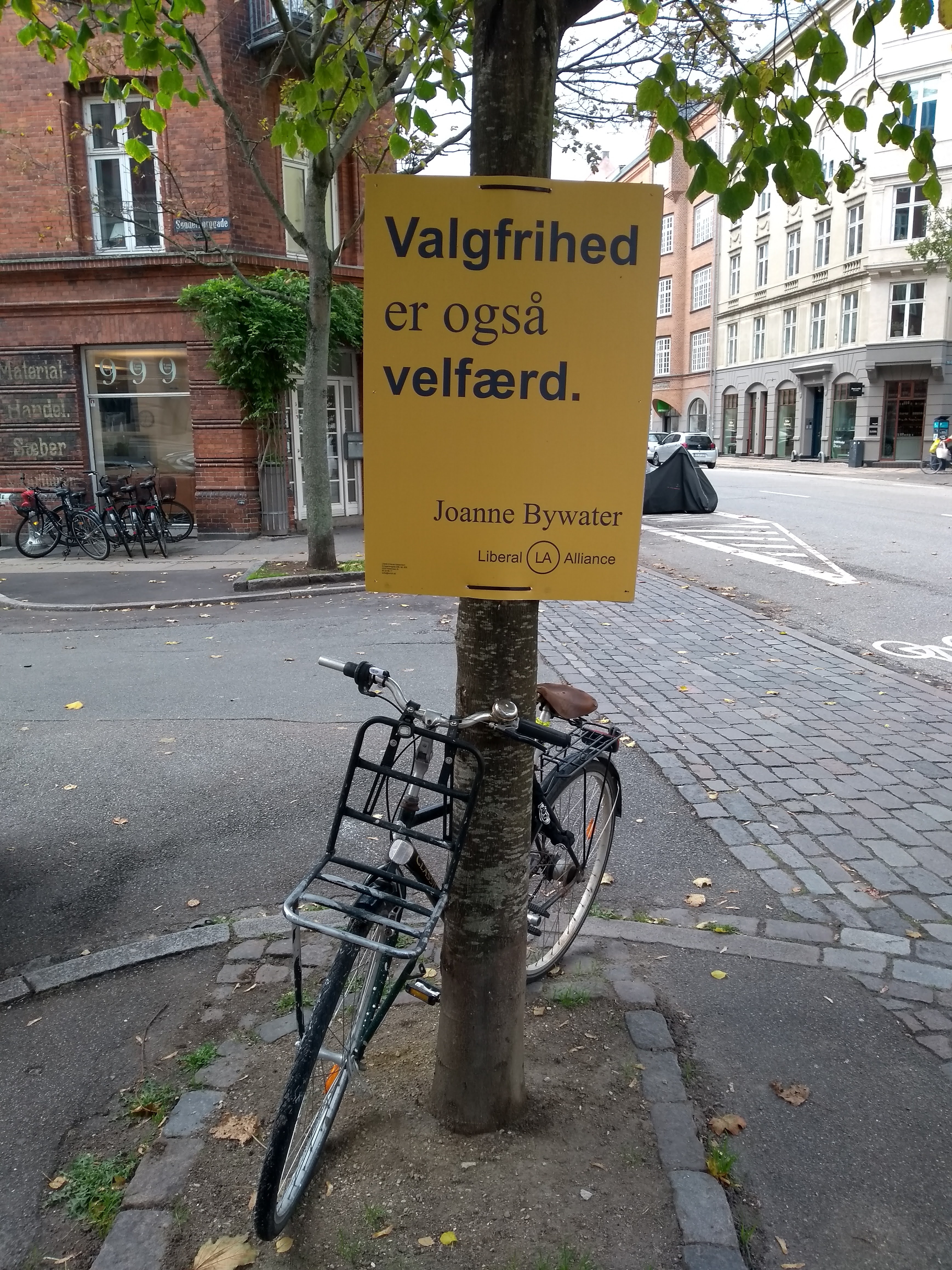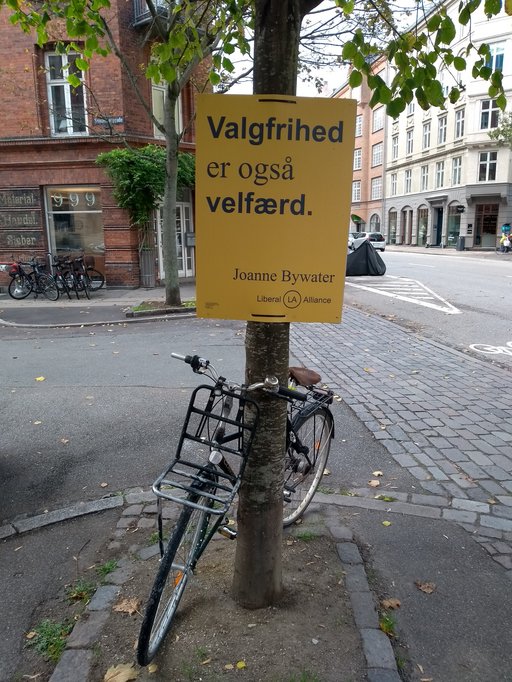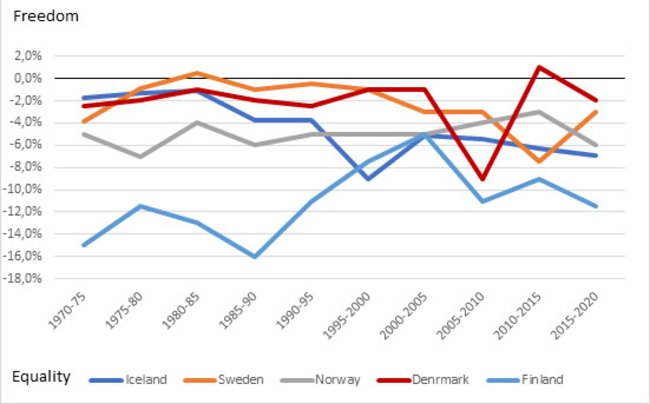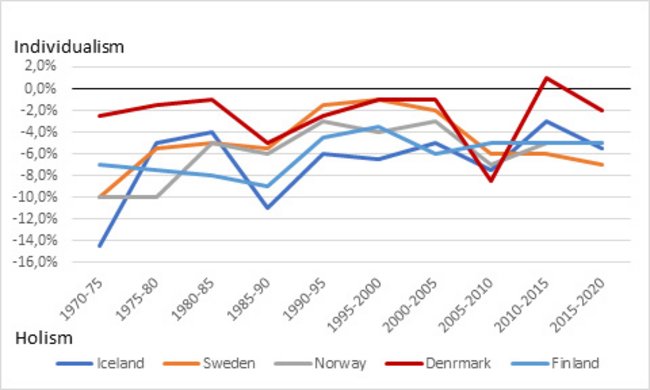Support for the welfare state persists in the Nordic countries despite move towards liberalism
Political rhetoric on welfare and a strong state still attracts voters despite the Nordic countries’ more liberal policymaking in recent years.


By analyzing voter support for different manifesto pledges over time, it can be seen that voter preferences in the Nordics seem to have stuck to classical Nordic values despite the drift to more liberal policy making.
How have the Nordic countries become more liberal?
Over the past two decades, the Nordic economies have had to respond to structural changes in the world economy, which came in the wake of the sovereign debt crisis in 2009-2010 and increasing globalization in financial and tangible goods and services. A review of different types of state expenditure from 1990 to 2019 does indeed reflect economic retrenchment towards the (generally lower) European norm. See this quick read for more detailed figures: Economic retrenchment and liberalization in the Nordic countries.
Social policy has become, in short, more liberal and less universal.
Have people’s values also changed over time to support (more) liberal policymaking?
It can be assumed that increasingly liberal policymaking is supported by the different electorates across the Nordics, and ideological rhetoric has followed suit. However, through a quantitative assessment of statements made in the relevant political manifestos over time and public support for them, I discovered that this is not in fact the case: Nordic populations still favor rhetoric about welfare despite liberalizing tendencies.
Using the Comparative Manifesto Project Database (CMP), it is possible to analyze large quantities of data to do with the manifestos of political parties in many areas of policy across countries. The database codifies the frequency that words about certain issues are mentioned in every political manifesto at every election year for each industrialized country from 1972, and this can be cross-referenced with the ultimate support for those parties at each election using a percentage calculation. The database can give an overview of whether there has been significant changes in rhetoric throughout the years by codifying the share of political attention that each party in the Nordic countries has for different policy areas.
A type of value hierachy
In order to use the database in a quantitative way in this context, it is necessary to boil rather abstract and wide-reaching concepts down to fundamental elements. While this may not encompass all the complexities of elections and policymaking, it has the advantage of being more objective than some other types of analysis - although there is of course some scope for error in my assessment of political variables. I developed a quantitative assessment of the statements (sentences and quasi-sentences) made in the manifestos, namely, through two axes, freedom-equality and holism-individualism. These different indicators were added together and then weighted by the vote percentage that each party received in a particular election.
In so doing, I was informed by several strands of the academic literature. One was the concept of "unexceptionalism" as discussed in the book "Scandinavian Unexceptionalism: Culture, Markets, and the Failure of Third Way Socialism" by Nima Sandaji. This has it that, in the Scandinavian countries, economic egalitarianism is properly balanced with personal autonomy in a way that communism never achieved. Unexceptionalism is the societal value that makes autonomous individuals also understand - through humility and civic engagement - that everyone is equal and has the same access to life opportunities. It has been argued that this can stifle ambition and engender a tendency to feel protected by society; however, one can be autonomous, but not exceptional, and therefore people are inclined towards moderation and privacy. Such unexceptionalism (it has been argued) can allow for redistributive policy and state intervention to address major inequalities.
The freedom-equality axis

The first axis puts together freedom and equality:
- The freedom measure incorporates indicators that code the support for economic variables, such as, free trade and welfare state retrenchment, as much as political variables such as support for upholding freedoms and human rights.
- The equality indicator is composed of the frequencies of political sentences in support of market regulation and state intervention and political variables such as support for labor groups and vulnerable disadvantaged minorities.
While equality can also be associated with certain human rights (particularly economic, social and cultural rights that attempt to equalize income and wealth), I chose here to attach them to the freedom dimension in the sense that they are generally conceived around the rights of the individual.
The individualism-holism axis

The second axis juxtaposes individualism and holism:
- The individualism indicator is composed of the sum, among others, of the share of sentences in party manifestos of economic variables such as the rejection of protectionism, nationalism and traditional morality, and support for multiculturalism and decentralization.
- The holism indicator includes the frequency of mentions towards environmental protection, state intervention in the economy, traditional morality and political authority.

Choices made for this axis were informed by the thoughts of sociologist Louis Dumont and epistemologist Karl Popper, who see the oppositions between the old collectivist thought at the basis of a hierarchical society, on the one side, and the values of individual liberty and equality, on the other. Against such a backdrop, 'holism' is deemed as a value that gives priority to the social aggregate over its individual components. A holist society usually has a conservative structure, where gender roles are fixed, state authority and group rights trump individual liberties through nationalism. Individualism is, conversely, a principle that instead conceives of autonomous individuals as primary agents who are empowered in the social system. Accordingly, a prevalently individualist society is characterized by a progressivist posture: trade liberalization, internationalism and the triumph of individual rights over the rights of the group and arbitrary state authority.
Putting the two axes together
It is also possible to put the two axes together to form quadrants for each of the Nordic countries to get an even fuller picture. The ideological plane is the locus of points whose x coordinate is the first difference of the Freedom-Equality and whose y axis is the first difference of the Individualism-Holism score.
[insert slide show]
What does the analysis of values show?
The Nordic countries are all almost exclusively to be found in the fourth quadrant of this particular ideological plane indicating a consistent preference towards equality and collectivism over time. This seems to suggest that, despite the liberalization process and the retrenchment in some welfare states (notably in Sweden), there remains strong support for a (more) interventionist state, redistributive tax and transfer policies, market regulation and a prevalence towards the welfare of the collectivity over individual well-being. Denmark and Sweden show more swinging ideological trends between elections, so it is possible to describe a greater support in these countries’ for policies on the side of individualism and freedom, at least at during those particular elections. It is possible to observe how a combination of economic freedom and individual autonomy still retains its grip in an "unexceptionalist" way.
Since at least the 1990s, the Nordic countries have been losing their status as a bastion of socialism with universal and generous welfare benefits, and have been moving closer to the EU average in terms of economic freedom and social spending. More recently, the Nordic way of life has been exposed to major changes, both in terms of welfare state retrenchment and labor market reforms. But this overview seems to suggest that what is perceived as ‘the Nordic way’ has, overall, not lost any ideological appeal despite economic adjustments to a more competitive economic landscape. There is evidence of support for an interventionist state despite contingent market adjustments that differ in each Nordic country.
These results also suggest that the elites in most Nordic countries have not changed their political discourses to adapt to the changed, hyper-globalized landscape. This potentially points to an important gap between the world of ideas and that of policy: if politicians are anchored to the same old stories, today’s changing landscape and rising problems of economic security need to be addressed. A recurring political supply of old narratives in a changing scenario also creates the fertile ground for populism and other political challenges to occur – and it begs the important question: if things fundamental change, shouldn’t words promptly follow suit?
Further reading:
- Bent Greve at el, ‘Nordic welfare states – still standing or changed by the Covid-19 crisis?’, Social Policy and Administration vol. 55 (2021), pp.295-311.
- C. De La Porte, ‘Going Nordic – Can the Nordic model tackle grand challen ges and be a beacon to follow?’, Regulation & Governance (2022).
- Johanna Kuhlmann, Klaus Schubert, Paloma de Villota, Challenges to European welfare systems (Springer International Publishing, 2016).
- L. Dumont, Essays on Individualism: Modern Ideology in Anthropological Perspective (Chicago: Univ. of Chicago Press, 1986, first published in French in 1983).
- L. Dumont, Homo hierarchicus; an essay on the caste system (Chicago: University of Chicago Press, 1966).
- Nima Sanandaji, Scandinavian Unexceptionalism: Culture, Markets and the Failure of Third-Way Socialism (The Institute of Economic Affairs, 2015).
- Susanne Alm, Kenneth Nelson et al., ‘The Diminishing Power of One? Welfare State Retrenchment and Rising Poverty of Single-Adult Households in Sweden 1988-2011’, European Sociological Review, 36(2) (2020), 198-217.
- S. Benediktsdottir, J. Danielsson, G. Zoega, The Iceland Collapse (Economic Policy).
- Stefan Hedlund, ‘Myths and realities of the Nordic welfare state’, Geopolitical Intelligence Services.
| Test | Formatting | |||
| Paternity leave | V | Y | ||